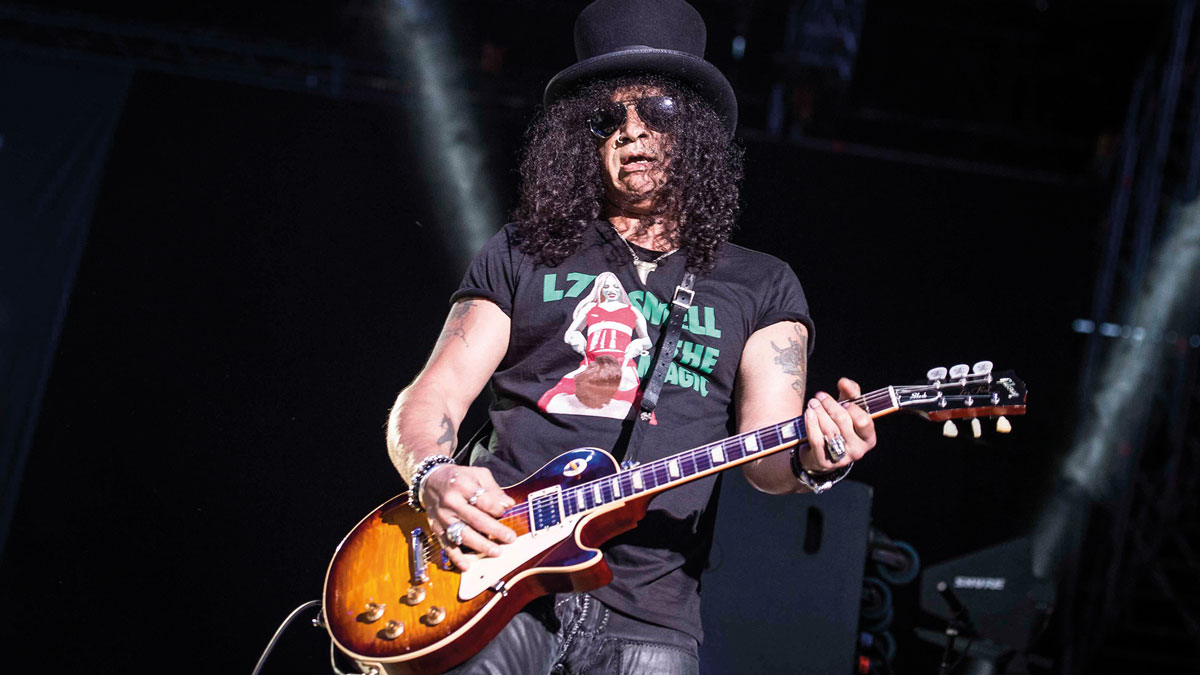Lessons you can learn from Slash‘s blues guitar solos
Learn how to keep your solos fresh and memorable with this look at the Guns N‘ Roses icon‘s bluesier side

Few guitarists are so synonymous with the wider culture as Slash, one of the most iconic rock stars the world has ever seen. Emerging in the late ’80s from LA’s hard rock scene, Slash, and his bandmates in Gun N‘ Roses, defined rock and roll for a whole generation.
Post-EVH in the late ’70s and early ’80s, the rock world had become dominated by the ‘glam’ movement, with huge hair, dive bombs and trying to play things as fast as possible. It might even be argued that rock was losing its attitude. Enter Guns N’ Roses who, almost overnight, re-injected that missing badass attitude and gravitas to the world of rock. A perfect blend of attitude and grit coupled with skilful songwriting and exciting playing, put this band ahead of its peers and re-captured the imaginations of the true rock-loving masses.
Many factors contributed, but one singular undeniable aspect is, of course, the man himself. Slash, along with six-string counterpart Izzy Stradlin, created some of the coolest riffs in rock. Combining that with Slash’s ballsy and melodic lead guitar approach, it was a welcome departure from the status quo of EVH copycats.
Slash’s playing is swaggering and gritty, with rapid-fire licks where needed. But it was his sense of melody that really made him stand out. It will be no surprise to Guitar Techniques readers that Slash is a lifelong fan of Queen and Brian May, and will certainly have developed his ear and love of melody from listening to these UK icons’ records while growing up.
But Slash also has tons of blues DNA in his playing. His sound is instantly recognisable, with the gutsy punch and attitude of punk, combined with a mature ear for melody and a deep grounding in blues language. As guitarists there are many things we can learn from Slash, but in particular is his mastery of playing over major tonalities in a fresh and exciting way.
In his recent work with Myles Kennedy, there is lots of hard-rocking pentatonic shred to enjoy, and loads we can learn from him there. But here we will be homing in on the iconic era for which he is most famously known.
Our studies will explore two favoured approaches. First, we will observe his use of major triads on which he so beautifully hangs his melodic ideas. With occasional added 2nd and perfect 4th, Slash is able to create soulful, memorable melodies that follow the chords, giving his playing that beautifully fluid and grounded sound.
Our second study sees a blending of Mixolydian tonality to give his melodies an even bluesier edge, and keep things sounding fresh.
Example 1. Mixing triads and scale tones
Our first study focuses on using triads with smatterings of the 2nd and 4th degrees with which to construct melodic ideas. Make note of how the phrases essentially revolve around small chord clusters and use the additional scale tones to lyrically link them together.
Example 2. Mixing major and minor
This study is in effect more of the same, but is here built around the key centre of E Major. Make note of the bend to a G natural in bar 8, giving us the sound of A7, and also the addition of a D note in Bar 11, hinting at the sound of E Mixolydian. This helps break up the Major scale sound and add a distinct bluesy flavour.
Get The Pick Newsletter
All the latest guitar news, interviews, lessons, reviews, deals and more, direct to your inbox!
Phil Short is a sought-after guitarist from the UK. A stadium player, Phil is well known for his technically accomplished guitar style and has showcased his talent touring with Irish boyband Westlife. As well as touring, Phil has been a visiting lecturer at BIMM London since 2017, teaching performance, technique and improvisational skills to the next generation of guitarists. Phil is a monthly contributor for Guitar Techniques magazine, writing the blues column as well as video features on iconic rock legends.










